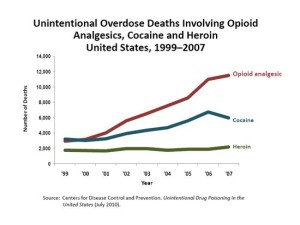Killing Us Softly with Prescription Drugs
And now, the top five abused prescription drugs of 2013 are: 1) OxyContin®, 2) Suboxone®, 3) Concerta, 4) Ambien and 5) Ritalin. Rounding out the top ten are: 6) Zoloft, 7) Lunesta, 8) Adderal XR, 9) Opana® ER, and 10) Xanax. Three of the top ten are prescribed for ADHD; two are prescribed for pain relief; another two are sleep aides. Plus there is a tranquilizer, an antidepressant and AN OPIOID MAINTENANCE DRUG! Don’t get me started about that one (Suboxone; buprenorphine). Well it’s actually too late to say that. See “Is Buprenorphine Just a New Head for the Hydra of Opiate Addiction?”
See a list of the top 17 abused prescription drugs here.
The website from which the information on the top abused prescription drugs was taken, GeneticEngineering & Biotechnology News also took a poll of its readers on whether the government should move to put limits on the availability and use of pain and mood-altering drugs. 52.7% said yes; 47.3% said no. It amazes me that the vote was so evenly split. I would have liked to see a higher percentage of yeses. Let’s look at some further information on the abuse of prescription drugs and then ask that question again.
For several years, the nonmedical use of prescription drugs has been the second most commonly abused illicit substance after marijuana. The rankings of most frequently abused illicit drugs for 2012 are: marijuana, pain relievers, tranquilizers, cocaine, stimulants, ecstasy, methamphetamine and THEN heroin. See my “2012 National Drug Use Summary” for more information.
Let’s look at some straight up statistics from the Center for Disease Control (CDC). The drug overdose death rate per 100,000 was approximately 1.0 in 1970. By 2007 that rate had risen to 9.18. The following graphic (to the left) is from the Office of National Drug Control Policy report on “Prescription Drug Abuse.”
There are now more unintentional overdose deaths from opioids than cocaine and heroin COMBINED, as illustrated by the additional graphic, also from the Office of National Drug Control Policy report on “Prescription Drug Abuse.” (to the right)
|
2000 |
2002 |
2004 |
2009 |
2010 |
|
|
All ages |
6.2 |
8.2 |
9.4 |
11.9 |
12.3 |
|
15-24 |
3.7 |
5.1 |
6.6 |
7.7 |
8.2 |
|
55-64 |
4.2 |
6.0 |
7.8 |
13.7 |
15.0 |
|
White males |
8.4 |
11.1 |
12.6 |
16.4 |
16.8 |
|
White females |
4.3 |
6.2 |
7.5 |
10.3 |
10.9 |
|
Black males |
10.8 |
11.5 |
11.1 |
10.8 |
10.1 |
|
Black females |
4.1 |
5.0 |
5.5 |
5.6 |
5.7 |
Further data from the CDC on death rates from opioid analgesics indicates that in the year 2000, the death rate per 100,000 of the US population for all ages was 6.2. By 2010 the rate had increased to 12.3. Among 15-24 year olds, the death rate was 3.7 in 2000 and 8.2 in 2010. For individuals between the ages of 55 and 64, the death rate was 4.2 in 2000 and 15.0 in 2010. White male death rates have increased from 8.4 in 2000 to 16.8 in 2010; white females from 4.3 in 200 to 10.9 in 2010. Rates for Black or African American males actually fell; Black female rates had a slight increase. See the table above for selected years and demographics. Go to the CDC report for additional information.



